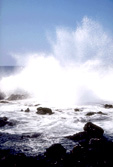![]()
![]()
![]()
![]() What
is Equity?
What
is Equity?
![]() Equity
Within Nations
Equity
Within Nations
![]() Equity
Between Nations
Equity
Between Nations
![]() International
Economic System
International
Economic System
![]()
![]()
![]() Global
Warming and Equity
Global
Warming and Equity
![]() •
Impacts
•
Impacts
![]() Responsibility
Responsibility
![]() Actions
Actions
![]() Australia
Australia
![]()
![]()
![]() References
References
![]() Site
Map
Site
Map
![]()
|
The consequences of global warming will be worst for countries that have contributed least to greenhouse gas emissions and who are least able to adapt |
The consequences of doing nothing
While the impacts of greenhouse warming are far from clear and often debated (see page 00), it seems that there would be some winners and some losers. If sea levels rise, island and coastal communities would suffer and those that would probably suffer most are low-lying low-income countries. It is these nations that often have the densest populations: they are least able to afford mitigation measures such as levees and dykes to hold the seawater back or to relocate substantial numbers of people.
Social and environmental costs of sea level rise will be highest in countries where deltas are extensive, densely populated, and extremely food-productive. In these countries, most of which are in the Third World, heavy reliance on groundwater and the completed or proposed damming and diversion of large rivers&emdash;for increased hydropower and agricultural use, for flood control, and for transportation&emdash;have already begun to compound problems with sea level rise. Almost without exception, the prognosis for these vulnerable, low-lying countries in a greenhouse world is grim. (Jacobson 1990, p. 88)
For example, even now, the densely populated nation of Bangladesh experiences storm surges up to 160 kilometres upriver. Such surges exact a heavy toll in losses of human lives, livestock and fishing vessels. As well as Bangladesh, the nations of Egypt, Gambia, Indonesia, the Maldives, Mozambique, Pakistan, Senegal, Surinam and Thailand have been identified as being the most vulnerable. Paradoxically, these countries have contributed little to the accumulation of greenhouse gases in the atmosphere.
The South Pacific Regional Environment Programme has identified global warming and sea level rise as 'the most serious environmental threats to the Pacific region':
Island countries are particularly vulnerable, because they include many hundreds of low-lying islands and atolls, house most of their populations and many important economic activities in coastal zones, depend on extremely scarce supplies of potable groundwater, have very limited areas of arable soil, and are at great risk from extreme natural events&emdash;for example, cyclones, droughts, earthquakes, volcanic eruptions and tectonic movements.The amount and rate of rise in sea level remains uncertain and this adds to our concern, as does the feeling of helplessness in the face of an environmental impact not of Pacific origin.(1992, p. 13)
Source: Sharon Beder, The Nature of Sustainable Development, 2nd edition, Scribe, Newham, Vic.,1996.
![]()
 Consequences
Consequences